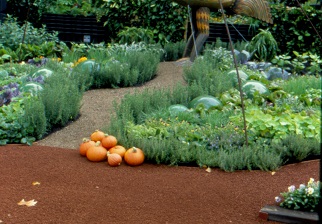 Cottage gardens had their earliest beginnings in the 17th century in Tudor gardens of the rural areas of England. The first cottage gardens were created on small plots of land around small cottages occupied by workers on the estates of wealthy landowners, or on fenced of parts of the road verge in front of cottages as roads were improved (and became narrower due to reduced need to avoid ruts and potholes). The need of the cottage occupiers to produce more food, and a desire to beautify their homes resulted, in a seemingly casual mixture of vegetables, flowers, shrubs and fruit trees developing. There was little space for lawn, though practical features such as paths, seats, weather vanes and sundials were used where space allowed. These gardens became increasingly popular with the general public through the 18th and 19th centuries, and the cottage garden style travelled abroad to places such as America and Australia with British immigrants and transported convicts. America and Australia developed their own styles of cottage gardens.
Cottage gardens had their earliest beginnings in the 17th century in Tudor gardens of the rural areas of England. The first cottage gardens were created on small plots of land around small cottages occupied by workers on the estates of wealthy landowners, or on fenced of parts of the road verge in front of cottages as roads were improved (and became narrower due to reduced need to avoid ruts and potholes). The need of the cottage occupiers to produce more food, and a desire to beautify their homes resulted, in a seemingly casual mixture of vegetables, flowers, shrubs and fruit trees developing. There was little space for lawn, though practical features such as paths, seats, weather vanes and sundials were used where space allowed. These gardens became increasingly popular with the general public through the 18th and 19th centuries, and the cottage garden style travelled abroad to places such as America and Australia with British immigrants and transported convicts. America and Australia developed their own styles of cottage gardens.
Modern Cottage Gardens
Although best suited to old world architecture, the modern cottage garden can be created around all types of buildings. Cottage gardens are a favourite style to many people due to the floral displays possible. They are ideally developed in sunny places, although if you choose your plants carefully you can still have a cottage garden in the shade. They usually contain little or no lawn, lots of colour, a large variety of textures and colours, edible and scented plants, and a variety of traditional features such as trellis, wrought iron, picket fencing, cast iron furniture, statues, topiary, low hedges, sundials and birdbaths. Plants include a mixture of ornamentals, herbs, fruiting types, even vegetables. Companion planting minimises pest and disease problems. These gardens allow for self-sowing to occur in order to fill up spaces to prevent weed growth. Once established they are easy to care for although trimming and pruning of selected plants (especially roses), and harvesting of produce may take time. There are many options for modern cottage gardens.

- A cottage garden entry where the entire front garden, or just the area immediately surrounding the pathway to the front door or driveway is turned into a cottage garden that frames the entry points.
- A cottage vegetable, fruit and herb garden that may be restricted to a specific part of your back garden, or include the entire garden.
- A cottage garden courtyard or living area, where seats, tables, and paved areas are surrounded by beds full of herbs, colourful flowers and fruiting plants.